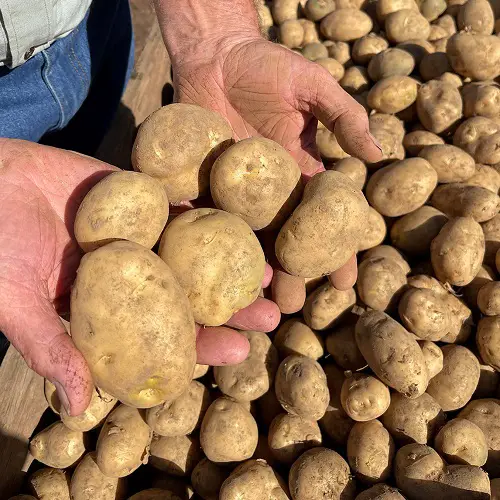Here are some Kennebec Potatoes Growing Tips and Facts that are surely going to surprise you! Keep on reading!
By following Kennebec Potatoes Growing Tips and Facts, you can enjoy homegrown, delicious, and nutritious Kennebec potatoes in your meals!
Check out 12 DIY Potato Pots to Grow Potatoes Without Digging here
Kennebec Potatoes Information
Kennebec Potatoes were first developed in the late 19th century in the state of Maine, USA. They were created by a guy named Herbert H. Hartwell, who was trying to breed a potato that was both disease-resistant and delicious.
Kennebec Potatoes are large with smooth, light brown skin that is often tinged with a pink hue. The flesh is white, firm, and has a slightly waxy texture. With these features, one can easily recognize this potato variety. So if you’re into gardening, Kennebecs are a great choice
Botanical Name: Solanum tuberosum ‘Kennebec’
USDA Zones: 3-10
Find Are Potatoes Vegetables or Fruits? Find Out
Kennebec Potatoes Growing Tips
 Planting
Planting
Kennebec Potatoes are typically planted in the spring, about 2-3 weeks before the last frost. Plant seed potatoes that are about 2-3 inches in size and have at least one “eye” or sprout.
Plant them in well-drained soil that has been amended with compost or other organic matter.
Pot Requirement
Typically, these potatoes are planted in the ground, but they can also be grown in pots or containers if you don’t have access to a garden.
To give your Kennebec potatoes enough room to grow, use a pot that is at least 18-22 inches in diameter and 16-18 inches deep.
Soil
The soil should be loose, well-draining soil with a pH of 5.0-5.5. The soil should have plenty of organic matter, such as compost, manure, or peat moss.
Watering
Potatoes need regular watering in order to thrive. For best results, water them with 1-2 inches of water per week, deeply and evenly, but avoid saturating the soil or standing water around the plants.
Make sure to water the soil, not the foliage, as wet foliage can encourage disease. Additionally, water your potatoes in the morning, as this will give the leaves time to dry off before nightfall. Also, it will be a good idea to let the topsoil dry a little bit before you water the plants again.
Fertilizer
For maximum yields, use a fertilizer that is specifically labeled for potatoes. Make sure to follow the directions on the package carefully.
Alternatively, you can also go for a balanced liquid feed. Feed it once after planting the potatoes, then apply a second application of fertilizer after the plants have started to flower. This will help ensure the potatoes are well-nourished and have enough nutrients to produce a good harvest.
Also, water the bed thoroughly after applying the fertilizer to help it get into the soil.
Read about Growing Blue Potato Bush here
Harvesting Kennebec Potatoes
Kennebec potatoes are typically ready to harvest about 90-100 days after planting. The plants will begin to die back, and the foliage will turn yellow when the potatoes are ready.
Carefully dig up the potatoes with a fork or shovel and let them dry in the sun for a few hours before storing them.
Put These 10 Things in Your Potato Planting Hole for Best Harvest
Kennebec Potatoes Facts
Here are some interesting facts about Kennebec potatoes:
- Kennebec potatoes were first developed in the late 19th century by a man named James J. H. Gregory in Maine, USA.
- These potatoes are named after the Kennebec River, which flows through Maine.
- They have a high yield and are known for their large size and uniform shape, which makes them ideal for commercial potato farming.
- Kennebec potatoes are also known for their long shelf life, which means they can be stored for several months without spoiling.
- They have a low water content, which makes them perfect for baking, frying, and roasting, as they crisp up nicely and don’t turn mushy.
- Kennebec potatoes are high in potassium, vitamin C, and fiber, making them a healthy addition to any diet.
Learn Growing Potatoes from Store Brought Potatoes here
Kennebec Potatoes Uses
They have a slightly nutty flavor and are perfect for roasting, mashing, frying, and making chips.
- To roast, preheat the oven to 375°F. Wash the potatoes, cut them into wedges, and place them on a baking sheet. Drizzle with olive oil and season with your favorite herbs and spices. Bake for 25-30 minutes or until golden brown and crispy.
- To make mashed Kennebec potatoes, boil the peeled and cubed potatoes for 15-20 minutes or until tender. Drain the potatoes and mash them with a potato masher. Stir in butter, milk, and salt and pepper to taste. Serve warm.
- To fry, heat a few tablespoons of oil in a large skillet over medium-high heat. Cut the potatoes into cubes and add to the skillet. Cook for 8-10 minutes, stirring occasionally, until golden brown and crispy. Serve with ketchup or your favorite dipping sauce.
- To make chips from Kennebec potatoes, preheat the oven to 375°F. Wash the potatoes and slice them thinly with a mandoline slicer. Place the slices on a parchment-lined baking sheet and brush with olive oil. Sprinkle with salt and pepper and bake for 15-20 minutes or until golden brown and crispy.




